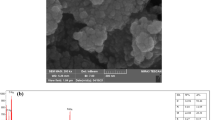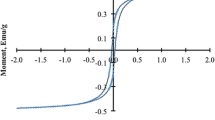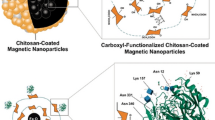Abstract
Polyvinylimidazole (PVI)-grafted iron oxide nanoparticles (PVIgMNP) were prepared by grafting of telomere of PVI on the iron oxide nanoparticles. Different metal ions (Cu2+, Zn2+, Cr2+, Ni2+) ions were chelated on polyvinylimidazole-grafted iron oxide nanoparticles, and then the metal-chelated magnetic particles were used in the adsorption of invertase. The maximum invertase immobilization capacity of the PVIgMNP–Cu2+ beads was observed to be 142.856 mg/g (invertase/PVIgMNP) at pH 5.0. The values of the maximum reaction rate (V max) and Michaelis–Menten constant (Km) were determined for the free and immobilized enzymes. The enzyme adsorption–desorption studies, pH effect on the adsorption efficiency, affinity of different metal ions, the kinetic parameters and storage stability of free and immobilized enzymes were evaluated.








Similar content being viewed by others
References
Girelli AM, Mattei E (2005) Application of immobilized enzyme reactor in on-line high performance liquid chromatography. J Chromatogr B 819:3–16
Krajewska B (2004) Application of chitin- and chitosan-based materials for enzyme immobilizations: a review. Enzyme Microb Technol 35:126–139
Arica MY, Soydogan H, Bayramoglu G (2010) Reversible immobilization of Candida rugosa lipase on fibrous polymer grafted and sulfonated p(HEMA/EGDMA) beads. Bioprocess Biosyst Eng 33:227–236
Coulet PR, Carlsso J, Porath J (1981) Immobilization of enzymes on metal-chelate regenerable carriers. Biotechnol Bioeng 23:663–668
Carlsson J, Axen R, Unge T (1975) Reversible covalent immobilization of enzymes by thiol-disulphide interchange. Eur J Biochem 59:567–572
Bayramoglu G, Altıntas B, Arica MY (2011) Reversible immobilization of uricase on conductive polyaniline brushes grafted on polyacrylonitrile film. Bioprocess Biosyst Eng 34:127–134
Gates B, Xia Y (2001) Photonic band gap properties of opaline lattices of spherical colloids doped with various concentrations of smaller colloids. Appl Phys Lett 78:3178–3180
Shimomura M, Sawadaishi T (2001) Bottom-up strategy of materials fabrication: a new trend in nanotechnology of soft materials. Curr Opin Coll Interf Sci 6:11–16
Huang SH, Liao MH, Chen DH (2003) Direct binding and characterization of lipase onto magnetic nanoparticles. Biotechnol Prog 19:1095–1100
Berry C, Curtis ASG (2003) Functionalization of magnetic nanoparticles for applications in biomedicine. J Phys D Appl Phys 36:198–206
Pankhurst QA, Connolly J, Jones SK, Dodson J (2003) Applications of magnetic nanoparticles in biomedicine. J Phys D Appl Phys 36:167–181
Luo L, Li Q, Xu Y, Ding Y, Wang X, Deng D, Xu Y (2010) Amperometric glucose biosensor based on NiFe2O4 nanoparticles and chitosan. Sens Actuat B Chem 145:293–298
Kaushik A, Solanki PR, Ansari AA, Sumana G, Ahmad S (2009) Iron oxide-chitosan nanobiocomposite for urea sensor. Sens Actuat B Chem 138:572–580
Qu S, Wang J, Kong JL, Yang PY, Chen G (2007) Magnetic loading of carbon nanotube/nano-Fe3O4 composite for electrochemical sensing. Talanta 71:1096–1102
Jordan J, Kumar CSSR, Theegala C (2011) Preparation and characterization of cellulase-bound magnetite nanopartiecles. J Mol Catal B Enzym 68:139–146
Xie W, Ma N (2010) Enzymatic transesterification of soybean oil by using immobilized lipase on magnetic nano-particles. Biomass Bioenergy 34:890–896
Wang H, Huang J, Wang C, Li D, Ding L, Han Y (2011) Immobilization of glucose oxidase using CoFe2O4/SiO2 nanoparticles as carrier. Appl Surf Sci 257:5739–5745
Namdeo M, Bajpai SK (2009) Immobilization of α-amylase onto cellulose-coated magnetite (CCM) nanoparticles and preliminary starch degradation study. J Mol Catal B Enzym 59:134–139
Melo JS, D’Souza SF (2000) A simple approach for the simultaneous isolation and immobilization of Invertase using crude extracts of yeast and Jack bean meal. J Biochem Biophys Method 42:133–135
Tanioka A, Yokoyama Y, Miyasaka K (1998) Preparation and properties of enzyme-immobilized porous polypropylene films. J Coll Interf Sci 200:185–187
Rao MA, Violante A (1991) Invertase β-fructosidase): effects of montmorillonite, AL-hydroxide and AL(OH)x-montmorillonite complex on activity and kinetic properties. Soil Biol Biochem 23:581–587
Vujčić Z, Miloradović Z, Milovanović A, Božić N (2011) Cell wall invertase immobilisation within gelatin gel. Food Chem 126:236–240
Yildiz HB, Kamaci M, Azak H, Secgin O, Suer O (2013) A comparative study: immobilization of yeast cells and invertase in poly(ethyleneoxide) electrodes. J Mol Catal B Enzym 91:52–58
Uzun K, Cevik E, Şenel M, Sözeri H, Baykal A, Abasıyanık MF, Toprak MS (2010) Covalent immobilization of invertase on PAMAMdendrimer modified superparamagnetic iron oxide nanoparticles. J Nanopart Res 12:3057–3067
Takafuji M, Ide S, Ihara H, Xu Z (2004) Preparation of poly(1-vinylimidazole)-grafted magnetic nanoparticles and their application for removal of metal ions. Chem Mater 16:1977–1983
Nelson N (1944) A photometric adaptation of the Somogyi method for the determination of glucose. J Biol Chem 153:375–380
Lowry O, Rosebrough NJ, Farr AL, Randall RJ (1951) Protein measurement with the Folin phenol reagent. J Biol Chem 193:265–275
Wejrzanowski T, Pielaszek R, Opalińska A, Matysiak H, Lojkowski W, Kurzydlowski KJ (2006) Quantitative methods for nanopowders characterization. Appl Surf Sci 253:204–208
Pielaszek P (2003) Applied crystallography proceedings of the xix conference, vol 43. Krakow Poland
Karaoğlu E, Deligöz H, Sözeri H, Baykal A, Toprak MS (2011) Hydrothermal synthesis and characterization of PEG-Mn3O4 nanocomposite. Nano Micro Lett 3:25–33
Karaoğlu E, Kavas H, Baykal A, Toprak MS, Sözeri H (2011) Effect of hydrolyzing agents on the properties of poly (Ethylene Glycol)-Fe3O4 nanocomposite. Nano Micro Lett 3:79–85
Durmus Z, Kavas H, Baykal A, Sozeri H, Alpsoy L, Çelik SÜ, Toprak MS (2011) Synthesis and characterization of L-carnosine coated iron oxide nanoparticles. J Alloy Comp 509:2555–2561
Kök S, Osman B, Kara A, Beşirli N (2011) Vinyl triazole carrying metal-chelated beads for the reversible immobilization of glucoamylase. J Appl Polym Sci 120:2563–2570
Rosa AH, Vicente AA, Rocha JC, Trevisan HC (2000) A new application of humic substances: activation of supports for invertase immobilization. J Anal Chem 368:730–733
Sarı M, Akgol S, Karataş M, Denizli A (2006) Reversible immobilization of catalase by metal chelate affinity interaction on magnetic beads. Indust Eng Chem Res 45:3036–3043
Sahmetlioglu E, Yürük H, Toppare L, Cianga I, Yagci Y (2006) Immobilization of invertase and glucose oxidase in conducting copolymers of thiophene functionalized poly(vinyl alcohol) with pyrrole. React Funct Polym 66:365–371
Isık S, Alkan S, Toppare L, Cianga I, Yagcı Y (2003) Immobilization of invertase and glucose oxidase in poly 2-methylbutyl-2-(3-thienyl) acetate/polypyrrole matrices. Europ Polym J 39:2375–2381
Torres R, Mateo C, Fuentes M, Palomo J, Ortiz C, Fernandez-Lafuente R, Guisan J (2002) Reversible immobilization of invertase on sepabeads coated with polyethyleneimine: optimization of the biocatalyst’s stability. Biotechnol Prog 18:1221–1226
Grigoriy S, Chaga J (2001) Twenty-five years of immobilized metal ion affinity chromatography: past, present and future. J Biochem Biophys Methods 49:313–334
Akgöl S, Denizli A (2004) Novel metal-chelate affinity sorbents for reversible use in catalase adsorption. J Molecul Catal B Enzym 28:7–14
Wu J, Luan M, Zhao J (2006) Trypsin immobilization by direct adsorption on metal ion chelated macroporous chitosan-silica gel beads. Int J Biol Macromol 39:185–191
Bahar T, Tuncel A (2002) Immobilization of invertase onto crosslinked poly(p-chloromethylstyrene) beads. J Appl Polym Sci 83:1268–1279
Author information
Authors and Affiliations
Corresponding author
Rights and permissions
About this article
Cite this article
Uzun, K., Çevik, E., Şenel, M. et al. Reversible immobilization of invertase on Cu-chelated polyvinylimidazole-grafted iron oxide nanoparticles. Bioprocess Biosyst Eng 36, 1807–1816 (2013). https://doi.org/10.1007/s00449-013-0955-x
Received:
Accepted:
Published:
Issue Date:
DOI: https://doi.org/10.1007/s00449-013-0955-x




